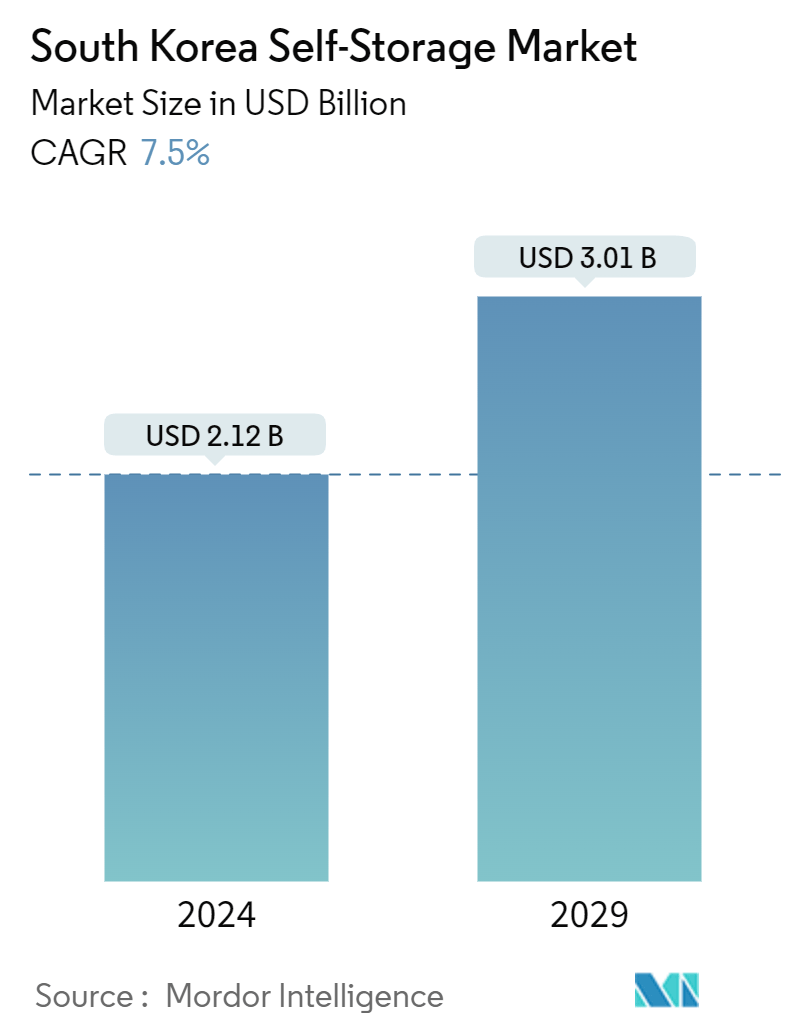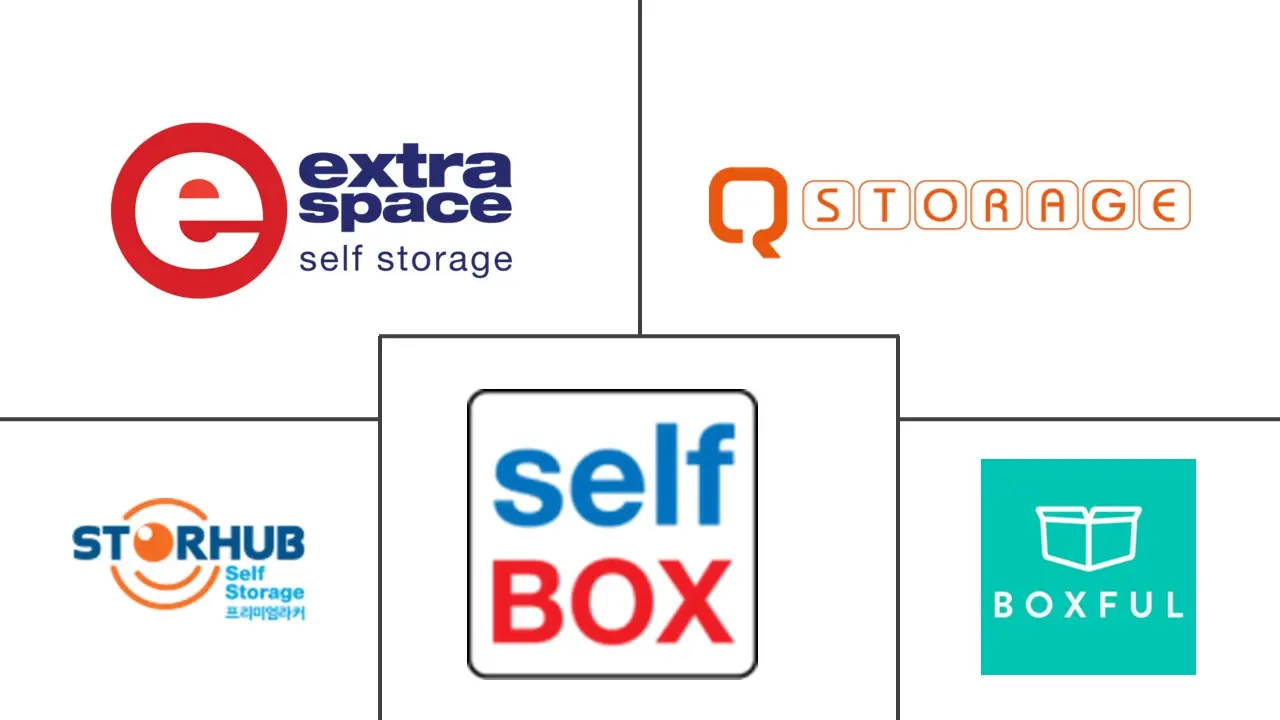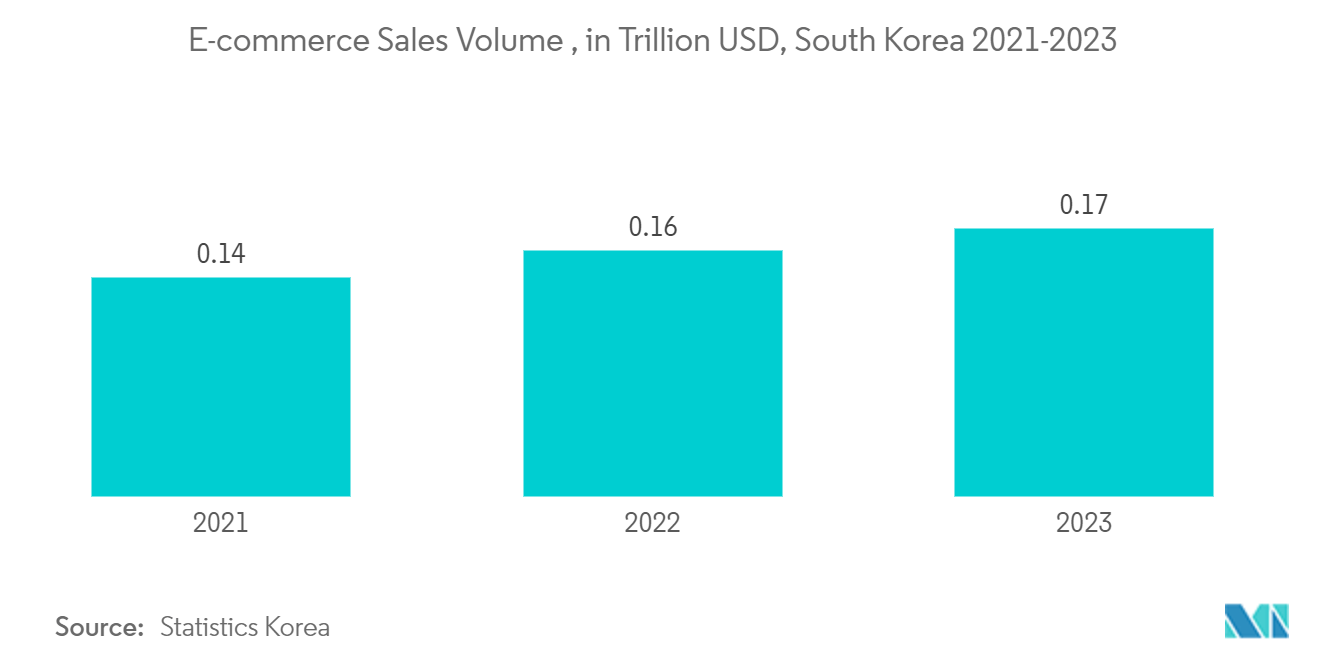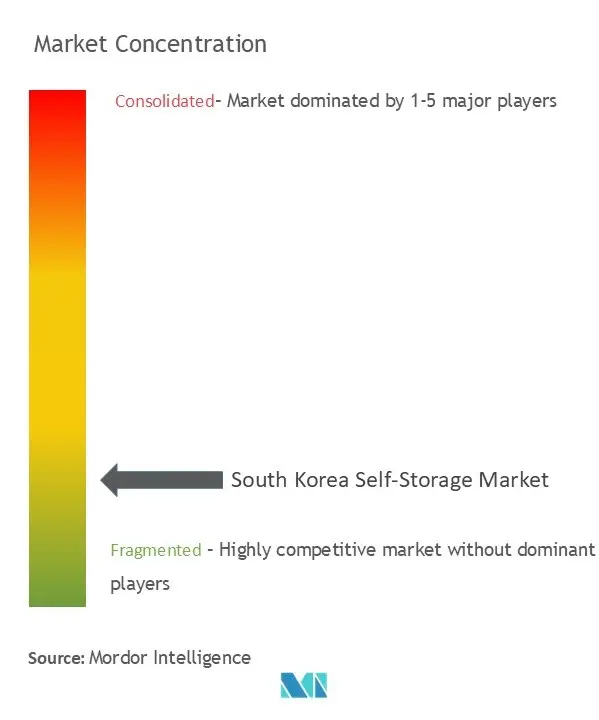South Korea Self-Storage Market Size

| Study Period | 2019 - 2029 |
| Base Year For Estimation | 2023 |
| Market Size (2024) | USD 2.12 Billion |
| Market Size (2029) | USD 3.01 Billion |
| CAGR (2024 - 2029) | 7.50 % |
| Market Concentration | Low |
Major Players
*Disclaimer: Major Players sorted in no particular order |
South Korea Self-Storage Market Analysis
The South Korea Self-Storage Market size is estimated at USD 2.12 billion in 2024, and is expected to reach USD 3.01 billion by 2029, growing at a CAGR of 7.5% during the forecast period (2024-2029).
- Urbanization Driving Demand for Self-Storage Solutions: South Korea's rapid urbanization is a key driver of the self-storage market. Over the past two decades, the urban population has increased by around 7 million, with 81% of the population now residing in cities. This shift has led to smaller living spaces, spurring demand for storage solutions.
- Population Density and Property Market Growth: Population density in South Korea reached 515 people per square kilometer in 2021, with Seoul having the highest density at 16,000 per square kilometer. This urban crowding, combined with a strong real estate sector that contributed KRW 138.36 trillion to the GDP in 2021, underscores the need for self-storage solutions.
- Property Price Concerns: A Gallup Korea study revealed that 57% of respondents expect property prices to continue rising, further squeezing living spaces and driving the demand for self-storage facilities.
- Flexible Work Arrangements Reshaping Storage Needs: The rise of remote and hybrid work in South Korea has created a new dynamic in the self-storage market. The shift has introduced storage needs for both individuals and businesses as workspaces are reorganized.
- Remote Work Surge: By August 2021, over 3.5 million workers in South Korea were using flexible work arrangements, a significant increase from 2.9 million in 2020. This shift has increased the need for decluttering home offices, fueling demand for self-storage solutions.
- Business Storage Requirements: Decluttering home offices and business spaces, along with the need to store infrequently used office equipment, is driving self-storage demand among employees adapting to flexible work models.
- Business Restructuring Boosting Self-Storage Demand: South Korea's changing business landscape, partly driven by global supply chain disruptions, is creating new demand for self-storage facilities.
- Reshoring and Downsizing: A 2022 survey by the Federation of Korean Industries found that 27.8% of major South Korean corporations were considering relocating their overseas operations back to South Korea, up from 3% in 2020. Meanwhile, 33.3% of small business owners in a 2021 survey reported considering the suspension of operations, contributing to the need for temporary storage solutions.
- Inventory Storage: Business closures and downsizing have led to a surge in demand for storage of inventory, furniture, and equipment in self-storage units.
- Evolving Self-Storage Market Characteristics: The South Korean self-storage market continues to evolve, with facilities adapting to meet diverse customer requirements and embracing technological advancements.
- Variety in Storage Sizes: Self-storage units offer a wide range of options, from 36,000 cm³ to 30,240,000 cm³, catering to different storage needs. Pricing models depend on factors like box quantity, locker size, and additional features such as hangers or containers.
- Technological Shifts: The market is shifting towards unattended, automated facilities similar to laundromats, with online reservations and virtual tours becoming increasingly popular for customer convenience.
- Market Structure and Growth Potential: The self-storage market in South Korea is expected to maintain steady growth, with a mix of leased and owned properties shaping its development.
- Facility Growth: By 2023, the number of self-storage facilities in South Korea is expected to reach 226, covering a lettable area of 513,246 sq. ft. Leased properties accounted for a larger share of the market compared to owned properties in 2021, though new entrants are increasingly interested in owning spaces.
- Building Conversions: The majority of new self-storage construction comes from building conversions, offering faster launch times than ground-up developments, helping to address space constraints in urban areas.
- Location and Technology Driving Market Dynamics: The success of self-storage facilities in South Korea is closely linked to their locations and the adoption of technology.
- Urban Center Focus: Small-scale storage facilities, especially in urban centers, prioritize accessibility via public transportation, catering to individual customers who need easily reachable storage solutions.
- Technological Integration: South Korea's technological strength enables innovative solutions such as easy online reservations, virtual unit selection, and automated services, making the storage process more efficient.
South Korea Self-Storage Market Trends
Personal Segment: Dominant Market Share
Personal storage needs remain the dominant driver of the South Korean self-storage market, holding 64% of the market share in 2021.
- Space Constraints and Urbanization: With 81% of the population living in urban areas, including 16,000 people per square kilometer in Seoul, shrinking living spaces drive the demand for self-storage. Rising real estate prices, as seen in a Gallup Korea study where 57% of respondents expect prices to rise, also push consumers to seek affordable storage options.
- Seasonal Storage: Personal storage also sees increased use for seasonal items such as sports equipment. Skis, golf clubs, and other seasonal goods are commonly stored in off-seasons, adding to the market’s growth trajectory.
- Technological Enhancements: Online reservations, electronic access systems, and climate-controlled units are becoming more prevalent, enhancing customer experience and contributing to the steady growth of the personal segment.
- Flexible Work Arrangements Impact Storage Needs: The rise in remote work has also influenced the demand for personal storage. With over 3.5 million workers using flexible work arrangements, decluttering home spaces has become a priority for many, spurring the need for additional storage solutions.

Business Segment Witness the Major Growth Trajectory
- Business Segment: Rapid Growth Trajectory While the personal segment dominates, the business segment is experiencing rapid growth.
- Economic Pressures: The business segment accounted for 36% of the self-storage market in 2021, up from 32% in 2019. Economic pressures, including rising costs, have driven businesses to seek flexible, cost-saving storage solutions.
- E-Commerce Boom: The rise of e-commerce is a significant driver of the business segment. Small and medium-sized enterprises use self-storage facilities to manage inventory and streamline order fulfillment, contributing to the rapid growth of this market segment.
- Reshoring Initiatives Impact Storage Needs: South Korean corporations are increasingly reshoring operations back to the country. Approximately 28% of major corporations reported considering reshoring in 2022, up from 3% in 2020. This trend is expected to fuel demand for business storage solutions as companies manage inventory and equipment during the reshoring process.

South Korea Self-Storage Industry Overview
Local Players Dominate Fragmented Market
The South Korean self-storage market is fragmented, with local players dominating the scene. A mix of specialized storage companies and real estate firms entering the sector characterizes the competitive landscape.
Projected Market Size: By 2023, the number of self-storage facilities is expected to reach 226, with a lettable area of 513,246 sq. ft. Leased properties currently account for 54% of the market, edging out self-owned properties.
Technological Innovation Drives Market Leaders
Major companies such as Extra Space Asia, Boxful Korea, and Storehub Korea Co., Ltd. distinguish themselves through innovation and strategic locations.
Technology Integration: These market leaders offer online reservations, flexible leasing terms, and facilities located near urban centers with easy access via public transport. For example, Nemo Storage saw a surge in demand due to the pandemic, attributed to reduced international travel and increased flexible work arrangements.
Factors for Future Success in the Market
Key success factors for companies in this market include technological advancements, optimal location selection, and flexibility in storage solutions.
Reshoring Impact: The reshoring of businesses back to South Korea, which increased from 3% in 2020 to 27.8% in 2022, offers opportunities for market expansion.
South Korea Self-Storage Market Leaders
-
Extra Space Asia
-
Boxful Korea
-
StoreHub Korea Co., Ltd.
-
QubizKorea Co.,Ltd (Q Storage)
-
Self Box
*Disclaimer: Major Players sorted in no particular order

South Korea Self-Storage Market News
- March 2024 - Boxful opened a new self-storage facility in Yeondong, Jeju City. The facility offers 24-hour unmanned storage services with customizable storage options for various items.
- January 2023 - KT Estate signed a strategic investment agreement with Second Syndrome, operator of 'Mini Warehouse Attic' self-storage service in Korea. The partnership aims to expand self-storage business in Korea by combining KT Group's infrastructure and ICT technology with Second Syndrome's operational expertise."
South Korea Self-Storage Market Report - Table of Contents
1. INTRODUCTION
- 1.1 Study Assumptions and Market Definition
- 1.2 Scope of the Study
2. RESEARCH METHODOLOGY
3. EXECUTIVE SUMMARY
4. MARKET INSIGHTS
- 4.1 Market Overview
-
4.2 Industry Attractiveness - Porter's Five Forces Analysis
- 4.2.1 Threat of New Entrants
- 4.2.2 Bargaining Power of Consumers
- 4.2.3 Bargaining Power of Suppliers
- 4.2.4 Threat of Substitute Products
- 4.2.5 Intensity of Competitive Rivalry
- 4.3 Industry Value Chain Analysis
- 4.4 Impact of COVID-19 on the Market
5. MARKET DYNAMICS
-
5.1 Market Drivers
- 5.1.1 Increased Urbanization Coupled with Smaller Living Spaces
- 5.1.2 Population Density and Property Market Growth
- 5.1.3 Flexible Work Arrangements Reshaping Storage Needs
- 5.1.4 Business Restructuring Boosting Self-Storage Demand
-
5.2 Market Restraints
- 5.2.1 Lack of Enough Space to Build Self-storage Facilities
- 5.2.2 Property Price Concerns
6. MARKET SEGMENTATION
-
6.1 By End-user
- 6.1.1 Personal
- 6.1.2 Business
7. COMPETITIVE LANDSCAPE
-
7.1 Company Profiles*
- 7.1.1 Extra Space Asia
- 7.1.2 Boxful Korea
- 7.1.3 Storehub Korea Co., Ltd.
- 7.1.4 Qubizkorea Co.,ltd (q Storage)
- 7.1.5 Self Box
- 7.1.6 Nemo S&S Co., Ltd. (nemo Storage)
- 7.1.7 Mini-storage (sampyo Energy)
- 7.1.8 Dalock
8. INVESTMENT ANALYSIS
9. MARKET OPPORTUNITIES AND FUTURE TRENDS
** Subject To AvailablitySouth Korea Self-Storage Industry Segmentation
Self-storage is an industry that rents storage space, such as rooms, locker rooms, containers, and outdoor space, also known as "storage units," to tenants, usually on a short-term basis. Self-storage is available for individuals and small and medium-sized businesses in flexible, shorter, or longer periods and thes storage facilities are highly professional and different from empty warehouses or attics.
The South Korea self-storage market is segmented by end-user (personal, business).The market sizes and forecasts are provided in terms of value (USD) for all the above segments.
| By End-user | Personal |
| Business |
South Korea Self-Storage Market Research FAQs
How big is the South Korea Self-Storage Market?
The South Korea Self-Storage Market size is expected to reach USD 2.12 billion in 2024 and grow at a CAGR of 7.5% to reach USD 3.01 billion by 2029.
What is the current South Korea Self-Storage Market size?
In 2024, the South Korea Self-Storage Market size is expected to reach USD 2.12 billion.
Who are the key players in South Korea Self-Storage Market?
Extra Space Asia, Boxful Korea, StoreHub Korea Co., Ltd., QubizKorea Co.,Ltd (Q Storage) and Self Box are the major companies operating in the South Korea Self-Storage Market.
What years does this South Korea Self-Storage Market cover, and what was the market size in 2023?
In 2023, the South Korea Self-Storage Market size was estimated at USD 1.96 billion. The report covers the South Korea Self-Storage Market historical market size for years: 2019, 2020, 2021, 2022 and 2023. The report also forecasts the South Korea Self-Storage Market size for years: 2024, 2025, 2026, 2027, 2028 and 2029.
South Korea Local Self Storage Industry Report
South Korea Self-Storage Market Research
Our in-depth industry analysis on the South Korea self-storage market offers comprehensive insights into the evolving dynamics of this sector. Covering key areas such as market growth, urbanization impact, and digital transformation, the report provides stakeholders with actionable data and trends shaping both residential and commercial demand. The self-storage market's development, fueled by factors like flexible work arrangements and reshoring initiatives, is thoroughly examined. This analysis not only captures the present state of the market but also delivers a forward-looking perspective, making it an essential resource for investors, developers, and business owners.
All findings and statistics are meticulously detailed in an easy-to-read report pdf format, ensuring clear and accessible information for all users. Key topics such as industry trends, market forecast, and the competitive landscape are explored, offering a full picture of the market’s trajectory. This enables stakeholders to make informed decisions on future investments and operational strategies, taking advantage of the substantial growth opportunities in South Korea’s self-storage market.



